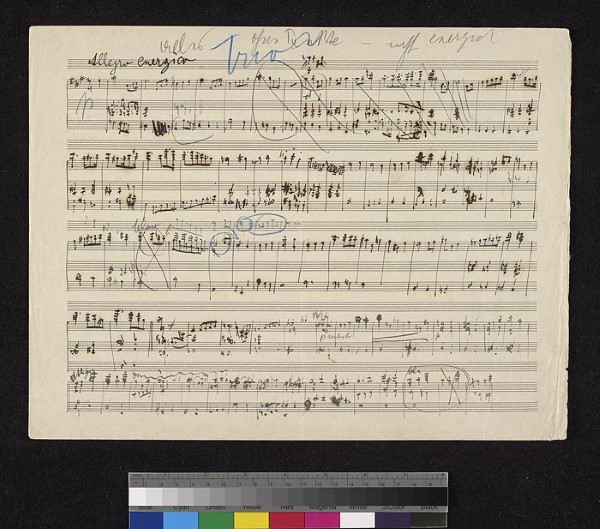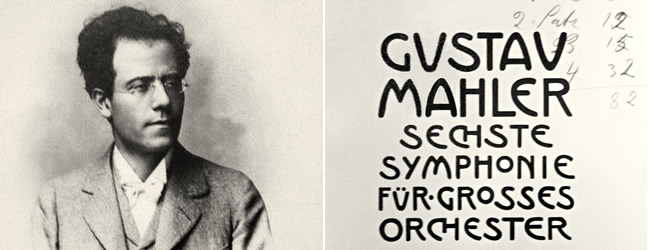The Symphony No. 6 in A minor by Gustav Mahler, sometimes referred to as the Tragische (“Tragic”), was composed between 1903 and 1904 (rev. 1906; scoring repeatedly revised). The work’s first performance was in Essen on 27-05-1906, and was conducted by the Gustav Mahler. The tragic, even nihilistic, ending of No. 6 has been seen as unexpected, given that the symphony was composed at what was apparently an exceptionally happy time in Mahler’s life: he had married Alma Schindler in 1902, and during the course of the work’s composition his second daughter was born.
The symphony is far from the most popular of Mahler’s works. Statistics compiled by League of American Orchestras show that over the seven seasons in the U.S. and Canada ending with 2008-2009, the symphony was programmed considerably less often than Symphonies Nos. 1, 2, 4, and 5. However, both Alban Berg (1885-1935) and Anton Webern (1883-1945) praised it when they first heard it: for Alban Berg it was “the only sixth, despite the Pastoral”; while Anton Webern conducted it on more than one occasion.
Structure
The work is in four movements:
Movement 1: Allegro energico, ma non troppo
Movement 4: Finale (Allegro moderato)
The order of the inner movements is a matter of debate. See History Symphony No. 6
Formally, the symphony is one of Mahler’s most outwardly conventional. The first three movements are relatively traditional in structure and character, with a standard sonata form first movement (even including an exact repeat of the exposition, unusual in Mahler) leading to the middle movements – one slow, the other a scherzo-with-trios.
However, attempts to analyze the vast finale in terms of the sonata archetype have encountered serious difficulties. As Dika Newlin has pointed out: “it has elements of what is conventionally known as ‘sonata form’, but the music does not follow a set pattern […] Thus, ‘expositional’ treatment merges directly into the type of contrapuntal and modulatory writing appropriate to ‘elaboration’ sections […]; the beginning of the principal theme-group is recapitulated in C minor rather than in A minor, and the C minor chorale theme […] of the exposition is never recapitulated at all”.
Tragische/Tragic
The status of the symphony’s nickname is problematic. The programme for the first Vienna performance (4-01-1907) refers to the work as ‘Sechste Sinfonie (Tragische)’, but only the words ‘Sechste Sinfonie’ appeared on the programme for the earlier performance in Munich on 08-11-1906. Nor does the word Tragische appear on any of the scores that Kahnt music publishers published (first edition, 1906; revised edition, 1906), or in Richard Specht (1870-1932)‘s officially approved Thematische Führer (‘thematic guide’), or on Alexander von Zemlinsky (1871-1942)‘s piano duet transcription (1906).
In his Gustav Mahler memoir, Bruno Walter (1876-1962) claimed that “Mahler called his Tragic Symphony”, and this is often cited in support of a nickname that many people clearly find congenial. The fact remains, however, that Mahler did not so title the symphony when he composed it; when he first performed it; when he published it; when he allowed Richard Specht (1870-1932) to analyse it; or when he allowed Alexander von Zemlinsky (1871-1942) to arrange it.
He had, moreover, decisively rejected and disavowed the titles (and programmes) of his earlier symphonies by 1900; and neither the “Lied der Nacht” subtitle of the Seventh Symphony, nor the “Sinfonie der Tausend” of the Eighth, stem from Mahler. For all these reasons, the Tragische nickname is not used in serious works of reference.
Quotations
- “My Sixth will propound riddles the solution of which may be attempted only by a generation which has absorbed and truly digested my first five symphonies”. Gustav Mahler, in a letter to Richard Specht (1870-1932).
- “My Sixth seems to be yet another hard nut, one that our critics’ feeble little teeth cannot crack”. Gustav Mahler, in a letter to Willem Mengelberg (1871-1951).
- “The only Sixth, despite the Pastoral”. Alban Berg (1885-1935), in a letter to Anton Webern (1883-1945)
Manuscript Symphony No. 6.
Manuscript Symphony No. 6 (detail).

Manuscript Symphony No. 6.
Listening Guide

